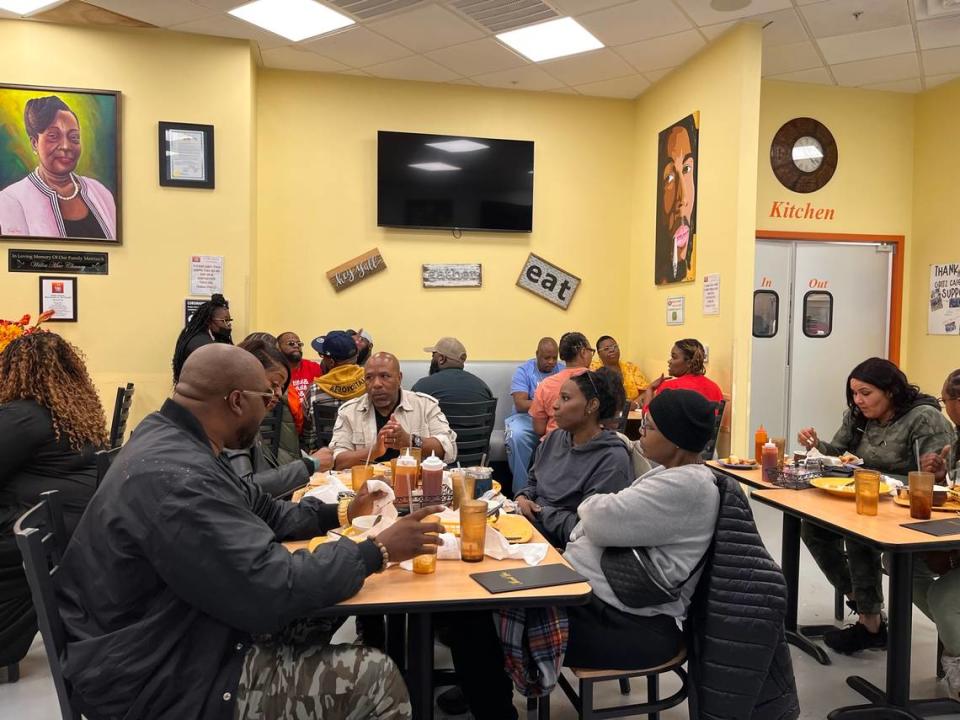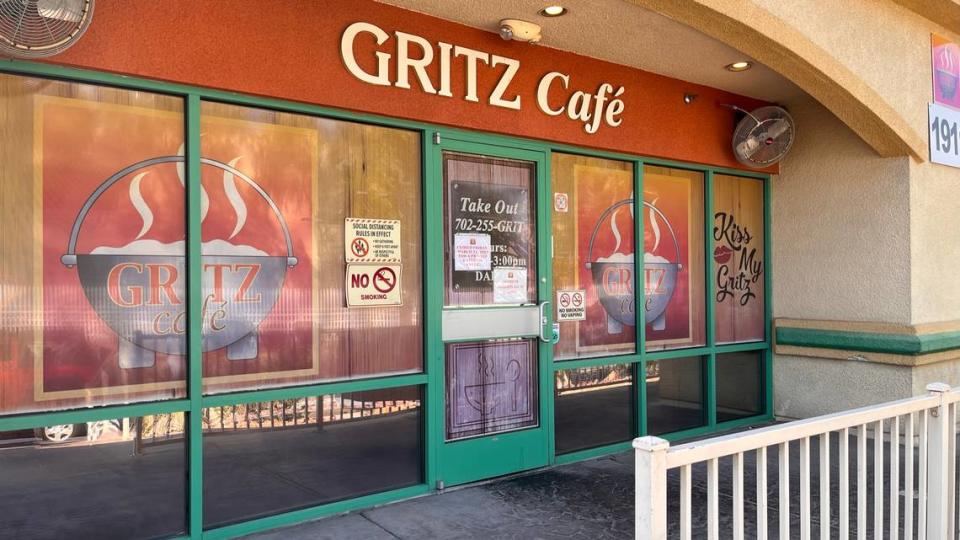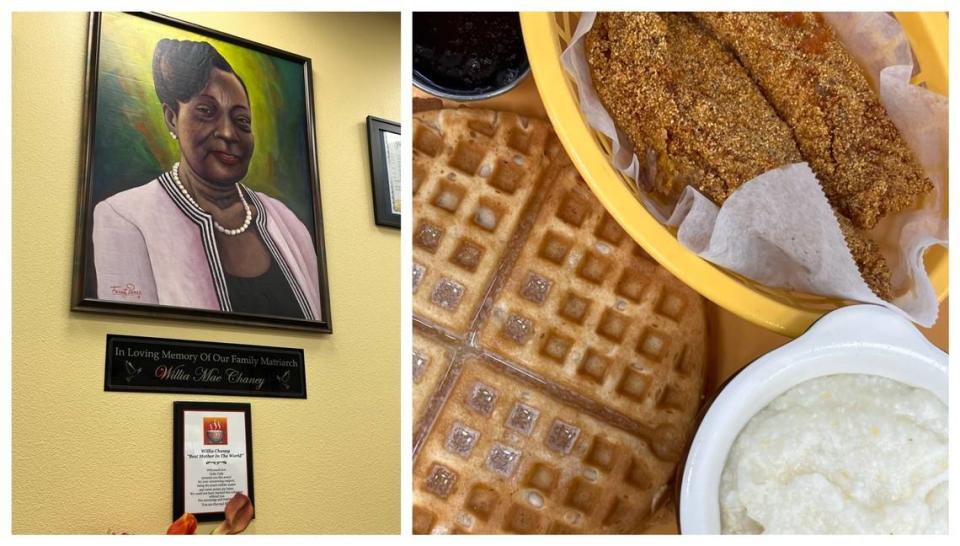Seeking Southern food in unlikely places, I rolled the dice in Las Vegas
- Oops!Something went wrong.Please try again later.
Buffets may be passé in Las Vegas, but casual gamblers still want to taste all the world has to offer. So now, instead of steam table stations, the ritziest casinos open restaurant “concepts,” with each featured global cuisine claiming its own name, menu and dining room.
At MGM Grand, toward the south end of The Strip, meal options include Ambra for chicken parmesan, Grand Wok Noodle Bar for pad Thai, and — since June 2022 — Nellie’s Southern Kitchen for biscuits, pulled pork and fried catfish.
The second location of a Belmont, North Carolina, restaurant created by The Jonas Brothers’ parents, Kevin and Denise, Nellie’s is a sit-down tribute to Kevin’s grandmother. “She was one of those special people who had a way of showing love through cooking,” Kevin told a PBS North Carolina crew. In Vegas, diners are greeted by a floor-to-ceiling painting of Nellie Jonas, with a skillet hanging from her waist and bolls of cotton adorning her hair.
While I’ve never ordered a plateful of pinto beans and cornbread in Vegas, I went to Nellie’s to test a theory.
This year, the Southern Foodways Alliance is taking on the question of “Where is the South?” acknowledging that the old boundaries established by politicians and breakfast preferences no longer capture the region and its character. With demographics shifting and economies changing, it’s become harder to define this place by latitude and longitude.

A decade ago, when I became food editor of the newspaper in Charleston, South Carolina, and fielded calls about where to buy soup bunch and how to pickle Jerusalem artichokes, the city seemed plenty Southern. Within six years or so, by which time nearly every reader call concerned either cheesesteaks or Chinese food, I wasn’t so sure.
Maybe, I thought, the South is where you take it. Over the coming year, I’ll be looking east, west, and north for edible evidence that what we consider Southern is flourishing under the stewardship of restaurant owners, chefs, and home cooks who have familial connections or spiritual affinity to the region.
First up, the West, where Nellie’s is furnished with just enough barnwood and electric guitars to alert guests bound for Grand Wok that they’re in the wrong place. Beyond those visual signifiers, though, the Southern vibe is weak: Not one of the restaurant’s listed cocktails is made with brown liquor, and I had to ask the bartender for hot sauce. Plus, according to online reviewers, there’s too much sugar in the collards and not enough in the tea.
Beyond ingredients, what struck me as off was one of the restaurant’s slogans, emblazoned on the back of a server’s T-shirt: “I’m just fat and happy!”
Many people in the South are fat, along with 42 percent of all Americans. Many people in the South are happy. But conflating the region with licentiousness and excess — messaging I’ve encountered at other Southern restaurants outside the traditional South — is a worn-out stereotype that didn’t make my beans taste any better. (Although at $10 a serving, they might be the best deal in a town that retired its 99-cent shrimp cocktail late last century.)
Seeking another take on Southern cuisine, I took a rideshare away from the tourist district, leaving behind the ersatz iconic buildings, video display towers promoting Bruno Mars’ upcoming residency, and billboards offering legal representation to people injured while searching for dead bodies in Lake Mead. Gritz Café is housed in a strip mall on the Westside, the historically Black section of a long-segregated city, its dining room concealed behind a curtained glass door.

It was a cold and windy day when I pulled that door open, so maybe the chatter rang livelier and the music brighter, in contrast to the dismal weather. But as restaurant regular Angie Graham said when we met up near the cash register, “It’s like Atlanta, isn’t it?”
I wasn’t the only one seeking a taste of the South at the butter yellow-walled Gritz Café, which quoted an hourlong wait when I arrived. Horace and Yolanda Robinson, who moved to Las Vegas in 2007 to look after Yolanda’s mother, had heard owner Trina Jiles talking about her restaurant on a local radio station just a few days earlier. Like me, they were making their first visit.
“I like to eat fish and grits, so I look for places like this,” said Horace, who was a frequent customer of soul food institution MacArthur’s when the couple lived in Chicago.
Yolanda, who was going over the menu, nudged her husband. “Let me get the chicken, and we’ll split,” she suggested.
According to manager Emma Nelson, Jiles opened Gritz in 2007 after learning the space next to her sister’s cosmetology school was available. (Jiles declined to speak with me but granted Nelson her blessing to speak on the restaurant’s behalf.) Nelson credited Jiles’ mother, Willia Mae Chaney, with setting the restaurant’s culinary course.
Chaney was born in Tallulah, Louisiana, just across the river from Vicksburg, Mississippi, same as Nelson’s mother, and just about every other Black resident of Las Vegas in the 1950s. The exodus from Tallulah was so concentrated that the Greyhound station there reportedly stopped selling one-way Vegas tickets to Black people because cotton farmers and mill owners complained they’d lost too many workers.
Lucille Bryant was a contemporary of Chaney’s. In Tallulah, Bryant made $5 a week as a domestic for a woman she called “Mrs. Severe,” even though she did “everything in her house except slept with her husband,” including — most likely — preparing dishes that she and Chaney both knew by heart.
But in Vegas, Bryant made her way not in the kitchen, but as a hotel maid.
As Bryant told a University of Nevada Las Vegas oral historian, once she moved to Las Vegas in 1953 and got a job at the Algiers Hotel, “I wrote back and I said, ‘Everybody come on out here. White folks gone crazy. They’re giving us $8 a day for making a bed and cleaning a bathroom.’” Bryant didn’t need to write twice: She soon welcomed “cousins galore” and so many neighbors “it was almost like walking down the street in Tallulah.” When Bryant later got a job as a housekeeper at The Stardust, her boss was Effie Conway, who had been her fourth-grade teacher back in Louisiana.
Bryant had intensely fond memories of meals in Tallulah. She recalled family suppers of fried chicken, tomatoes, and corn, and “old-fashioned eating” in the churchyard, with “chocolate cake, coconut cake, chicken and dressing, neck bones … and barrels of lemonade.”
Nelson, the Gritz manager, never learned her grandmother’s recipe for dressing, partly because she wanted to believe her grandmother would always be around to make it. But ways to make smothered chicken and sweet potato pie were handed down in other families over the years, and the recipes for catfish and pork chops at Gritz are heirlooms.
“The food is authentic,” Nelson said of the restaurant’s appeal to locals and tourists alike. She ventured that “what sets it apart is the texture.” By that, she meant everything is appropriately “crispy.”
My fried pork chop was indeed crispy, and another regular told me he appreciates that Gritz never undercooks his wings. But I’d wager (hey, it’s Vegas!) that true Southern food fans — or at least Black members of that group who are aware of the Westside — are coming for the metaphysical texture too.

Just as at Nellie’s, there’s a large portrait on the wall at Gritz. But unlike Nellie Jonas, whose descendants remember her as coming home from the mill and making pretty biscuits before combing the cotton out of her hair, Chaney is depicted as the embodiment of achievement. She represents not the coddling — and resultant indulgence — at the heart of Nellie’s approach, but the highest of standards.
A respected Westside leader who passed away in 2020, Chaney is pictured with a string of pearls around her neck, and her straightened hair set asymmetrically. She’s wearing glossy red lipstick, a pastel purple suit jacket, and a look that can only be described as astute.
Beneath the painting, Gritz Café has posted an award certificate proclaiming Chaney “Best Mother in the World,” citing her as a source of inspiration and unwavering support, as well as the restaurant’s signature peach cobbler.
What’s clear is Chaney’s portrait stands for community and continuity, values which have a distinct Southern flavor — even 1,562 miles from Madison Parish.
This story first appeared in The Food Section, a Charleston-based newsletter covering food and drink across the American South. To learn more about the James Beard Award-winning publication, visit thefoodsection.substack.com.

